The Bulldozer Review: AMD FX-8150 Tested
by Anand Lal Shimpi on October 12, 2011 1:27 AM ESTPower Management and Real Turbo Core
Like Llano, Bulldozer incorporates significant clock and power gating throughout its design. Power gating allows individual idle cores to be almost completely powered down, opening up headroom for active cores to be throttled up above and beyond their base operating frequency. Intel's calls this dynamic clock speed adjustment Turbo Boost, while AMD refers to it as Turbo Core.
The Phenom II X6 featured a rudimentary version of Turbo Core without any power gating. As a result, Turbo Core was hardly active in those processors and when it was on, it didn't stay active for very long at all.
Bulldozer's Turbo Core is far more robust. While it still uses Llano's digital estimation method of determining power consumption (e.g. the CPU knows ALU operation x consumes y-watts of power), the results should be far more tangible than what we've seen from any high-end AMD processor in the past.
Turbo Core's granularity hasn't changed with the move to Bulldozer however. If half (or fewer) of the processor cores are active, max turbo is allowed. If any more cores are active, a lower turbo frequency can be selected. Those are the only two frequencies available above the base frequency.
AMD doesn't currently have a Turbo Core monitoring utility so we turned to Core Temp to record CPU frequency while running various workloads to measure the impact of Turbo Core on Bulldozer compared to Phenom II X6 and Sandy Bridge.
First let's pick a heavily threaded workload: our x264 HD benchmark. Each run of our x264 test is composed of two passes: a lightly threaded first pass that analyzes the video, and a heavily threaded second pass that performs the actual encode. Our test runs four times before outputting a result. I measured the frequency of Core 0 over the duration of the test.
Let's start with the Phenom II X6 1100T. By default the 1100T should run at 3.3GHz, but with half or fewer cores enabled it can turbo up to 3.7GHz. If Turbo Core is able to work, I'd expect to see some jumps up to 3.7GHz during the lightly threaded passes of our x264 test:
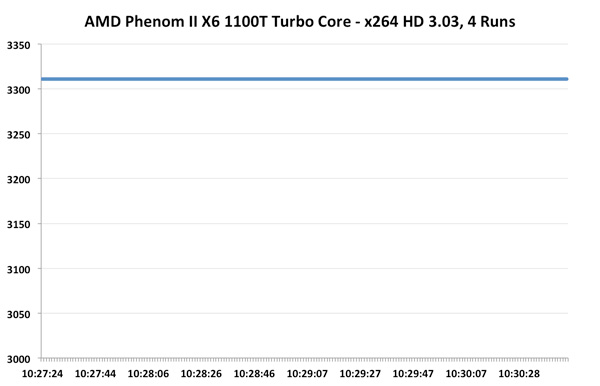
Unfortunately we see nothing of the sort. Turbo Core is pretty much non-functional on the Phenom II X6, at least running this workload. Average clock speed is a meager 3.31GHz, just barely above stock and likely only due to ASUS being aggressive with its clocking.
Now let's look at the FX-8150 with Turbo Core. The base clock here is 3.6GHz, max turbo is 4.2GHz and the intermediate turbo is 3.9GHz:
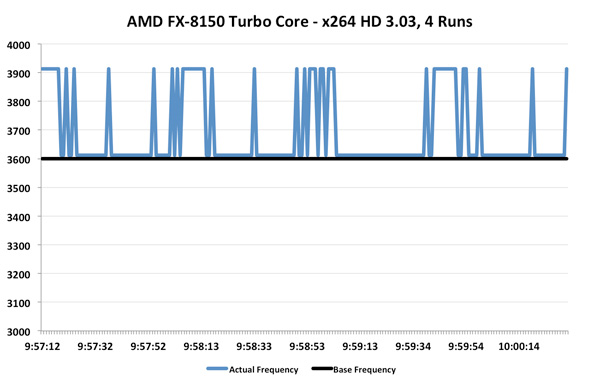
Ah that's more like it. While the average is only 3.69GHz (+2.5% over stock), we're actually seeing some movement here. This workload in particular is hard on any processor as you'll see from Intel's 2500K below:
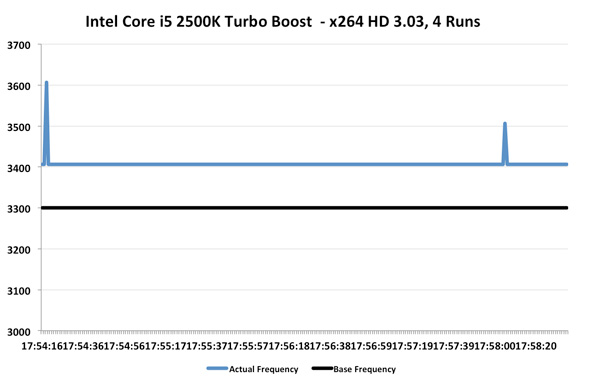
The 2500K runs at 3.3GHz by default, but thanks to turbo it averages 3.41GHz for the duration of this test. We even see a couple of jumps to 3.5 and 3.6GHz. Intel's turbo is a bit more consistent than AMD's, but average clock increase is quite similar at 3%.
Now let's look at the best case scenario for turbo: a heavy single threaded application. A single demanding application, even for a brief period of time, is really where these turbo modes can truly shine. Turbo helps launch applications quicker, make windows appear faster and make an easy time of churning through bursty workloads.
We turn to our usual favorite Cinebench 11.5, as it has an excellent single-threaded benchmark built in. Once again we start with the Phenom II X6 1100T:
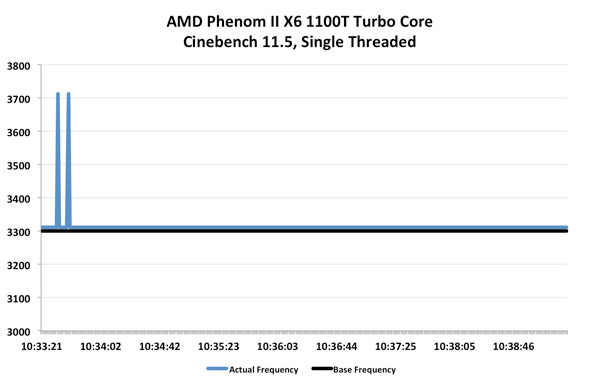
Turbo Core actually works on the Phenom II X6, albeit for a very short duration. We see a couple of blips up to 3.7GHz but the rest of the time the chip remains at 3.3GHz. Average clock speed is once again, 3.31GHz.
Bulldozer does far better:

Here we see blips up to 4.2GHz and pretty consistent performance at 3.9GHz, exactly what you'd expect. Average clock speed is 3.93GHz, a full 9% above the 3.6GHz base clock of the FX-8150.

Intel's turbo fluctuates much more frequently here, moving between 3.4GHz and 3.6GHz as it runs into TDP limits. The average clock speed remains at 3.5GHz, or a 6% increase over the base. For the first time ever, AMD actually does a better job at scaling frequency via turbo than Intel. While I would like to see more granular turbo options, it's clear that Turbo Core is a real feature in Bulldozer and not the half-hearted attempt we got with Phenom II X6. I measured the performance gains due to Turbo Core across a number of our benchmarks:

Average performance increased by just under 5% across our tests. It's nothing earth shattering, but it's a start. Don't forget how unassuming the first implementations of Turbo Boost were on Intel architectures. I do hope with future generations we may see even more significant gains from Turbo Core on Bulldozer derivatives.
Independent Clock Frequencies
When AMD introduced the original Phenom processor it promised more energy efficient execution by being able to clock each core independently. You could have a heavy workload running on Core 0 at 2.6GHz, while Core 3 ran a lighter thread at 1.6GHz. In practice, we felt Phenom's asynchronous clocking was a burden as the CPU/OS scheduler combination would sometimes take too long to ramp up a core to a higher frequency when needed. The result, at least back then, was that you'd get significantly lower performance in these workloads that shuffled threads from one core to the next. The problem was so bad that AMD abandoned asynchronous clocking altogether in Phenom II.
The feature is back in Bulldozer, and this time AMD believes it will be problem free. The first major change is with Windows 7, core parking should keep some threads from haphazardly dancing around all available cores. The second change is that Bulldozer can ramp frequencies up and down much quicker than the original Phenom ever could. Chalk that up to a side benefit of Turbo Core being a major part of the architecture this time around.
Asynchronous clocking in Bulldozer hasn't proven to be a burden in any of our tests thus far, however I'm reluctant to embrace it as an advantage just yet. At least not until we've had some more experience with the feature under our belts.


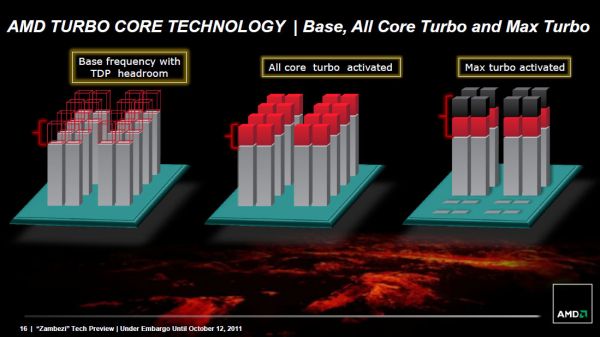








430 Comments
View All Comments
dingetje - Wednesday, October 12, 2011 - link
i agree with some that bulldozer is more like faildozer, but...let's keep supporting amd so the one getting piledrive'd in the naughty place will not be you when intel has zero competition left because you did not want to spend a little more for a little less....and let's be honest, it IS just a little.
if enough ppl drop amd, in the end WE will be the one paying for amd's lack of support.
at least amd is trying.....the question is, what are YOU going to do to stop intel becoming your bunghole-piledriving overlord?
wolfman3k5 - Wednesday, October 12, 2011 - link
Supporting incompetence is like socialism (or even communism). Eventually those that are supported will sit around like dogs all day and do nothing but lick their hairy balls...dingetje - Wednesday, October 12, 2011 - link
ah...someone has been brainwashed by watching to much fox news.communism baaaad boogabooga!! ....duhhhhh lol roflmao
sure, capitalism works...however, it only works when there actually IS competition.
i wish your (most likely already loose) rectum good luck.
wolfman3k5 - Wednesday, October 12, 2011 - link
Apparently money won't motivate the Monkey Engineers at AMD, so maybe making fun of them will. I mean, where is their pride, right?By the way, I've seen real socialism, so I have a clue what it is. And it is what I just described. I don't like Intel because they are not healthy for our economy, yet their only competition just pulled a gigantic fuck-up.
dingetje - Wednesday, October 12, 2011 - link
oooooo oooga boooga socialism is bad....it take away aaalll you money...it verrry baddd.....oooooogabooogaboooo!! LOLhave fun getting eaten alive by china after your capitalistic model became cancerous and will die from the inside out.
your country is bought and paid for and will be eaten alive by the "communistic" chinese who are in fact just the same as what the usa has become: a corporate dictatorship (not communism and certainly not socialism).
sorry, i didnt mean to scare you more than you obviously already are.
i would send you some lube to easy the pain, but i'm all out ;)
UberApfel - Wednesday, October 12, 2011 - link
My god you're all so retarded...Dingetje; China has serious issues when it comes to the welfare of their people. China only owns 10% of our debt, and that is thanks to China becoming capitalistic as a nation.
Wolfman; Bulldozer is a server procressor. The server market is where the money is especially with the cloud and enthusiast-class desktops becoming rare. Intel has 30X AMD's market capital... they can afford to target multiple markets. AMD can't.
Bulldozer is superior with integer processing in both performance-per-core and performance-per-watt. Of course; I do wonder why desktop applications even need floating point... (numbers < -2^63 or > 2^63)
hasu - Wednesday, October 12, 2011 - link
Like wise... killing or trying to control competition is also communism.radium69 - Wednesday, October 12, 2011 - link
Jeebus, that power consumption is going through the roof!Also there were some rumors that it would go up to 8Ghz, I wonder if would use a Kw by then...
I want to see how they compare to each other when overclocked to 4,5 or more or less.
Also Anand, can you do a efficiency test? Various overclocking speeds and bench these while monitoring the power consumption. Might make an interesting article :)
ypsylon - Wednesday, October 12, 2011 - link
Not really - even including AMD fanboys. AMD can't understand that to move forward you must abolish old stuff for good. Brand new and spanking Bulldozer has it roots in ancient K6. Do something new for crying out loud or get lost and stop wasting time. Don't release CPUs just for the sake of offering something. That is not the point of CPU market. Even Intel can shoot themselves in the foot with X79. Looks like it will be similar failure to FailDozer. Nobody will invest in entirely new platform for 10 maybe 15% performance boost over X58 which is the new 775 socket. Long live the S1366! Plenty of life and fuel left in Nehalems, plenty... If you wanted to buy Bulldozer then go and buy X58 platform. After nearly 4 years on the market it is [somewhat ;)] dirt cheap.Anand one thing: I find it puzzling that you reckon that Bulldozer will do well in server environments. With that kind of performance/Watt and inefficient power management? No chance in hell. i7/Xenons will eat FailDozers for breakfast.
wolfman3k5 - Wednesday, October 12, 2011 - link
I'm not. I completely agree with everything that you've said.And, if I might add: Dear AMD, and dear AMD engineers (and lazy fucks that you are), throwing more cache at an already inefficient architecture is not going to solve your problem. Add to that that you people (yes, you AMD people) are calling a 4 Core CPU an 8 Core because you've added another Integer Unit to each core. WTF?! That's almost like calling a quad core Intel 2600K and 8 Core CPU because it has Hyper Threading.
I have been an avid AMD supporter since 1996. I have spent many thousands of dollars on your CPUs and other hardware that you people make. I'm done. Not another penny! Ever!